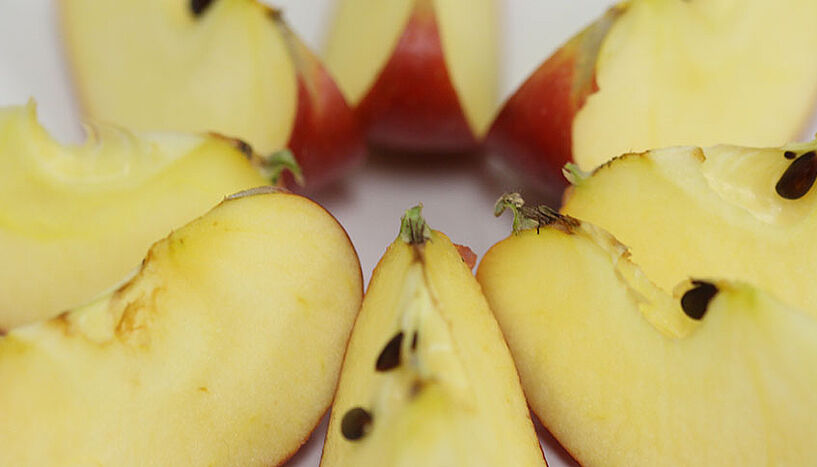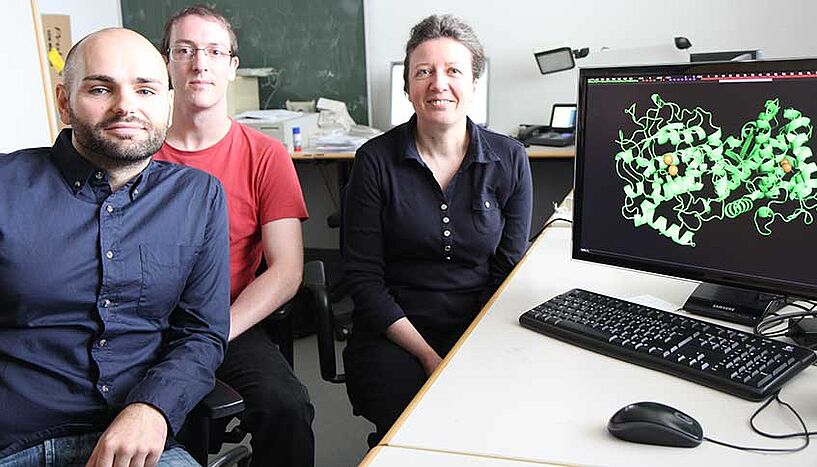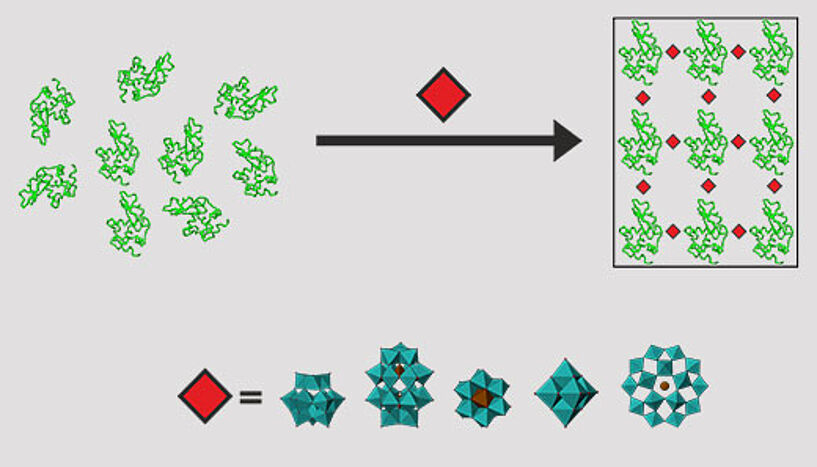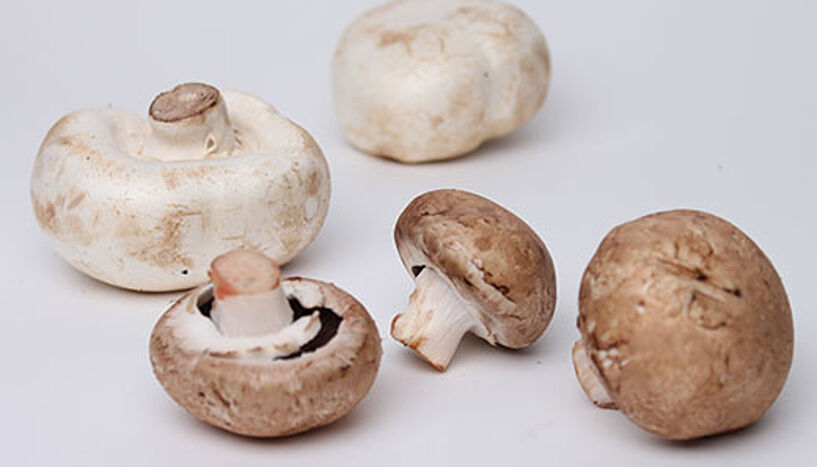No more brown apples?
| 11. November 2015The longer an apple retains its beautiful colour, the better it is – especially for the food industry. Therefore, the industry works intensely on inhibiting the "browning" of fruits. Chemists of the University of Vienna around Annette Rompel moved a step closer to this ultimate goal.
"Mommy, I am not going to eat this apple." Everybody knows this phenomenon: After slicing an apple, it loses its appetising white colour very quickly, which does not only scare off children. Although browned fruit is not harmful, we unwillingly eat "old-looking" fruit and throw away huge quantities of fresh products each year.
The reason for this ugly colouring is a chemical reaction, which is due to the catalysis caused by the enzyme tyrosinase. Actually, this “browning” is a defence mechanism of plants. "There are caterpillars which are starving to death with a full stomach, because they are no longer able to digest the material which is altered by the tyrosinase", explains Matthias Pretzler, member of the Department of Biophysical Chemistry at the University of Vienna, who was involved in the structure elucidation of the first plant tyrosinase together with his colleagues and under the supervision of Annette Rompel. The research results have now been published in the internationally-renowned journal "Angewandte Chemie" (applied chemistry).
From mushroom to the walnut leaf
The tyrosinase, which is a metal-containing enzyme catalysing the oxidation of phenols, has been explored by Annette Rompel for over 20 years. It is also involved in the synthesis of human melanin and therefore responsible for human "browning" as well. "In the 1990s we were far away from handling the enzyme, but with the development of modern chromatographic and crystallographic methods there are better opportunities available to us today", says Annette Rompel, who already tried to isolate and purify the enzyme from walnut leaves.
After the successful characterisation and crystallisation of mushroom tyrosinase in 2014, the walnut leaf is the centre of her research nowadays. "Walnut leaves make the skin become brown, which proves that they contain a high concentration of the enzyme and represent an attractive source for our research", she explains.
![]()
Annette Rompel and her co-workers conduct fundamental research. Their aim is to better understand the tyrosinase reaction. "New insights in this field would represent a considerable step forward, especially in the pharmaceutical area", say the scientists. In biotechnology, for example, the tyrosinase is used, among others, as a cross-linking catalyst in order to provide the active substance with additional functionalities or to encapsulate it. (Image: Andrea Damm/Pixelio)
Old theory is replaced by new findings
On the basis of the crystallisation of tyrosinase from walnut leaves, the researchers disproved a common theory. The tyrosinase belongs to the enzyme class of polyphenol oxidases. It catalyses the first two reactions (hydroxylation and oxidation) of the melanin biosynthesis. "Besides the tyrosinase, the so-called catechol oxidase is found in plants, which, however, is only able to catalyse the second reaction (oxidation)", says Matthias Pretzler.
Both enzymes are very similar as far as the structure is concerned. "This raises the question how the results of the individual reactivities differ from each other", adds Aleksandar Bijelic. It was previously assumed that tyrosinase differs from catechol oxidase by one single amino acid, which is virtually positioned over the active centre like a "plug" and thus responsible for the different reactivities. After the scientists of the University of Vienna have crystallised the first plant tyrosinase, they discovered that both enzyme classes contain this "plug" in plants. "Our conclusion is that we have to change the perspective", says the PhD student.
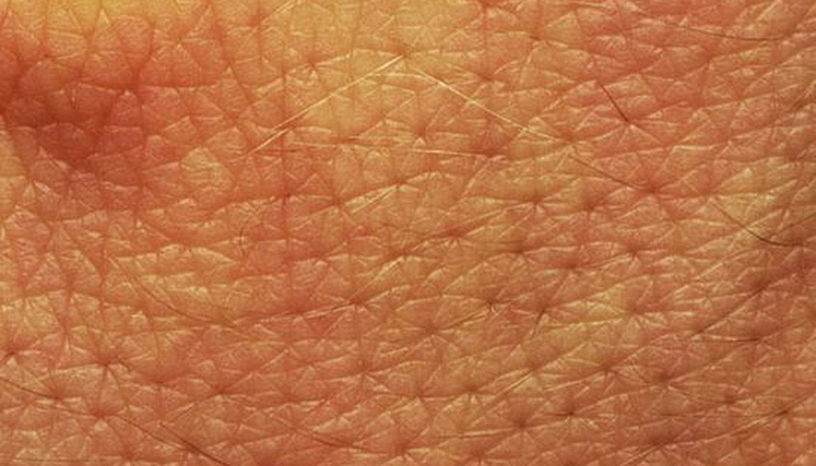
With their research, the chemists of the University of Vienna also contribute to a better understanding of human tyrosinase. In humans, the tyrosinase is involved in the synthesis of melanin at the membrane of melanocytes. Thus, it protects us from UV irradiation and is responsible for our pigmentation. However, the human tyrosinase is still not sufficiently understood.
Developing new perspectives
Accordingly, the team shifted its focus from the active site to more distant structural regions of the enzyme. "Our assumption is that some sort of pre-orientation has to take place in order to allow a substrate to gather the active site despite the presence of the 'plug' so that it can be finally converted by the tyrosinase", says the project leader. Thus, the scientists "zoomed out" a little bit and focused towards the amino acids at the second shell, which is located at the entrance of the active site. "In fact, we learned that these amino acids play a more important role than previously assumed", says Rompel.
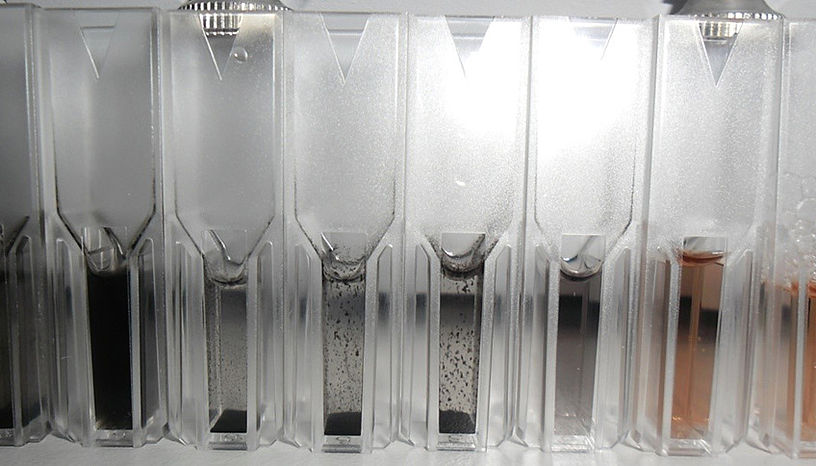
Chemists of the University of Vienna crystallised a plant tyrosinase for the first time. The tyrosinase is responsible, among others, for the browning of apples. "We do not know how to precisely control or turn off this reaction, but our research was a first step in the right direction", emphasises the first author Aleksandar Bijelic (talking about the publication in "Angewandte Chemie" (applied chemistry).
Understanding the underlying principle
"For many years, researchers studying tyrosinases found themselves confronted with the question: Why do you always obtain unexpected reaction products? Even if you feed it with the same substrate, different products can be obtained", says Annette Rompel. Her goal is it to understand the principle behind this, i.e. how the enzyme, namely tyrosinase, actually functions. If this succeeds, it will be possible to block the browning reaction in fruits.
Suppressing the activation of browning
The research group has already started its next project in order to address exactly this issue and to find a harmless method to control the tyrosinase. For this purpose, they have to find out how the enzyme is actually activated. "We want to find the enzyme that 'switches' the tyrosinase from latent to active", explains the scientist. "If we are successful in suppressing the first activating step, this will be an enormous success for science", adds Annette Rompel und smiles. "It would mean that a banana would not turn brown anymore if you squeezed it in your bag." Still, it would, of course, rot. "It will most probably rot even faster", concludes Matthias Pretzler. (Text: Petra Schiefer/ Translation: Team of Annette Rompel)
The publication "The First Plant Tyrosinase Structure from Walnut Leaves Reveals the Importance of ‘Substrate-Guiding Residues’ for Enzymatic Specificity" (authors: A. Bijelic, M. Pretzler, C. Molitor, F. Zekiri, A. Rompel) was published on 16 October in "Angewandte Chemie" (applied chemistry).
The publication "Crystallization and preliminary X-ray crystallographic analysis of polyphenol oxidase from Juglans regia (jrPPO1)” (authors: F. Zekiri, A. Bijelic, C. Molitor, A. Rompel) was published on May 2014 in "Acta Cryst".
The publication "Purification and characterization of tyrosinase from walnut leaves (Juglans regia)" (F. Zekiri, C. Molitor, S.G. Mauracher, C. Michael, R. L. Mayer, C. Gerner, A. Rompel) was published on January 2014 in "Phytochemistry".
The publication is part of the FWF stand-alone project "Strukturelle Charakterisierung von Typ 3-Kupferproteinen", which runs from 1 March 2013 to 29 February 2016 under the supervision of Professor Annette Rompel, Head of the Department for Biophysical Chemistry. Co-workers of the project are Matthias Pretzler and Aleksandar Bijelic.

